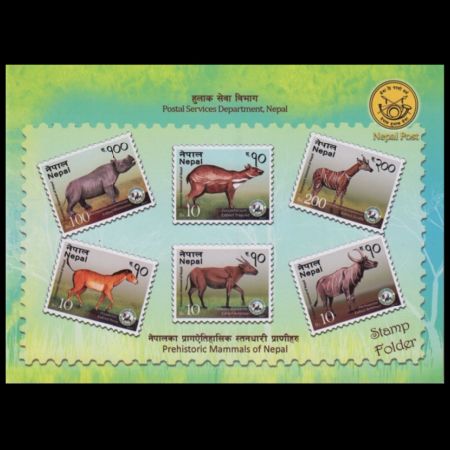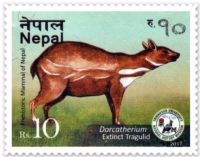Nepal 2017 "Prehistoric Mammals of Nepal"
| << previous page | back to index | next page >> |
| Issue Date | 22.09.2017 |
| ID | Michel: 1247-1252 ; Scott: 1044-1049 ; Stanley Gibbons: 1295-1300 ; Yvert et Tellier: 1235-1240 Category: pR |
| Design | Design: Purna Kala Limbu Consultant: Dr. Ramesh Shrestha, Chief, Natural History Museum, Nepal |
| Stamps in set | 6 |
| Value |
Rs. 10 - Extinct Antelope Pachyportax Rs. 10 - Extinct Horse Hipparion Rs. 10 - Extinct Tragulid Dorcatherium Rs. 10 - Extinct Antelope Hemibos acuticornis Rs. 100 - Extinct Rhinoceros Brachypotherium perminese Rs. 200 - Extinct Giraffe Giraffokeryx punjabiensis |
| Size (width x height) | 45 mm x 35 mm |
| Layout | 40 stamps per sheet |
| Products | Stamp folder x 1 |
| Paper | Self-adhesive, Security Stamp paper with special gumming |
| Perforation | 11 x 11 |
| Print Technique | Offset Lithography / Photogravure |
| Printed by | Perum Peruri, Indonesia |
| Quantity | 5.000.000 stamps in total |
| Issuing Authority | His Majesty's Government of Nepal Postal Services Department |

On September 22nd, 2017, the Post Authority of Nepal in cooperation with the Natural History Museum of Nepal issued the third stamp set of prehistoric animals. This time, the stamps were issued as self-adhesive and a stamp folder was produced instead of FDC.
Many extinct mammals inhabited the modern territory of Nepal during the Cenozoic Era, the “Age of Mammals”. Fossils (mostly teeth, skulls and individual bones) of 26 different types of prehistoric mammals have been discovered in various parts of Nepal prior to these stamps being issued. This set shows 6 of the 26 prehistoric Nepalese Mammals, another 10 of these animals were shown on the sets issued by Nepal in 2013 and 2015.
Pachyportax
Pachyportax, an extinct antelope that lived during the Miocene and Pliocene epochs, 15.97 to 3.6 million years ago in Asia.
Pachyportax nagrii is the most primitive species of the genus, originating in the Siwalik region of Nepal. Pachyportax was moderate to gigantic in size, ground dwellers who behaved as browsers and grazers.
It’s fossils, mostly teeth, are found in different rivers in western Nepal.
Hemibos acuticornis
Hemibos acuticornis, an extinct even-toed ungulate belonging to the bovidae family. Its fossil remains were found in Europe and Asia including Nepal.
This animal was very similar to the modern Indian Buffalo, which is likely a descendant of Hemibos.
It was characterized by elongated and not prominent frontal bones; the horn cores of the horns did not have a neck at the base, and the angle between the horns was variable but usually between 85 ° and 110 °.
Oriented backwards in the Hemibos acuticornis species, but oriented outwards and slightly upward in other species.
The genus Hemibos was first described in 1865 by Ruetimeyer, based on fossils found in India in Plio-Pleistocene soils.
In Nepal, fossils of Hemibos were discovered from the Surai Khola and Rato Khola formations.
Hipparion
Hipparion, is an extinct genus of three-toed horse that lived in North America, Asia, Europe, and Africa during the Miocene through Pleistocene 23 million to 781 thousands years ago.
Hipparion was one of the first grazing horses, subsisting on grass. It resembled a smaller version of the modern horse, with an estimated height at the shoulders of 1.4 meters and weight between 135 and 200 kg.
Hipparion probably ran much like a modern thoroughbred horses though it likely wasn't quite as fast.
Like other advanced horses of the Miocene, Hipparion supported it body weight upon a single toe that ended with a hoof. Other toes were still present on either side of this toe, but they were reduced in size and didn't touch the ground.
In Nepal, fossils of Hipparion were discovered at the Tui Khola, Balim Khola, Dang-Deukhuri and Tinau Khola regions.
Dorcatherium
Dorcatherium, is an extinct genus of tragulid ruminant which lived in Europe, East Africa and the Siwaliks (Nepal) during the Miocene and Pliocene.
Tragulidae, also called Chevrotains, are known as mouse-deer
or little goat.
Most of the Asian species have a weight between 0.7 and 8 kg.
In Nepal, fossils of Dorcatherium were discovered at many regions including the Tui Khola, Kalapani Khola and Rapti River.
Brachypotherium perminese
Brachypotherium perminese, is an extinct species of rhinoceros, that lived in Europa, Asia and Africa through the middle-upper Miocene, 17 to 4 million years ago.
The skull of Brachypotherium was relatively short and had wedge-like shape with the length of approximately 71 cm and probably had no horn.
Brachypotherium was a large rhinoceros with an estimated weight of 5 tons, and was among the largest known rhinoceroses. A characteristic feature of the skeleton were the shortened massive limbs of 49 cm long with a radius of up to 36 cm.
The structure of the limbs, but especially the hand and foot bones, also suggests that it moved in more open terrain, so swampy areas were probably rarely visited. A frequently postulated semi-aquatic lifestyle, as its hippopotamus-like habitat would suggest, has not yet been proven. The frequent association of Brachypotherium with the proboscideans of the genus Deinotherium, which preferred a similar landscape, supports these views. In Nepal, several fossil fragments were discovered at the Tui Khola, Balim Khola, Dang-Deukhuri and Tinau Khola regions.
Giraffokeryx punjabiensis
Giraffokeryx punjabiensis, is an extinct genus of medium-sized giraffid known from the Miocene of the Indian subcontinent and Eurasia.
It is distinguished from other giraffids by the four ossicones on its head; one pair in front of the eyes on the anterior aspect of the frontal bone and the other behind the eyes in the frontoparietal region overhanging the temporal fossae.
Ossicones are columnar or conical skin-covered bone structures on the heads of giraffes, male okapi, and some of their extinct relatives.
It has a brachydont dentition like in other giraffids and legs and feet are of medium length. Giraffokeryx resembled either an okapi or a small giraffe. It is a possible ancestor of both.Related stamps
| "Fossils of Nepal" | "Natural History Museum of Nepal" | "Prehistoric elephants of Nepal" |
 |
 |
 |
Products and associated philatelic items
| Souvenir Folder | ||
 |
|
|

|
 |
References
-
Technical details and short description of the stamps:
- Natural History Museum of Nepal Wikipedia
-
Description of prehistoric animals depicted on the stamps:
- Book "Prehistoric Mammals of Nepal", by Prof. Ramesh Shresta, published in 2015 in Nepal. ISBN: 978-9937-2-9672-4
- Hemibos: Wikipedia
- Hipparion: Hipparion
- Dorcatherium: Wikipedia
- Brachypotherium: Wikipedia (German version is more detailed)
- Giraffokeryx: Wikipedia
Acknowledgements
- Many thanks to Dr. Peter Voice from Department of Geological and Environmental Sciences, Western Michigan University, for reviewing the draft page and his valuable comments.
| << previous page | back to index | next page >> |





